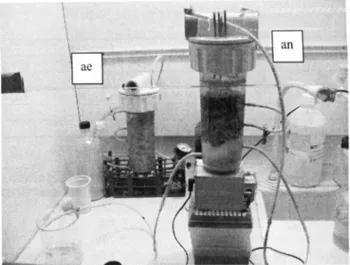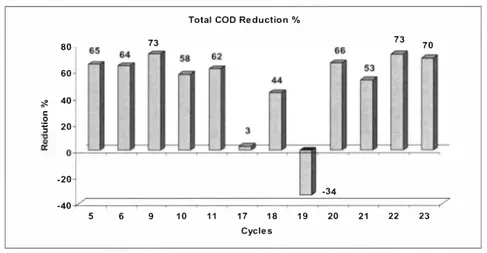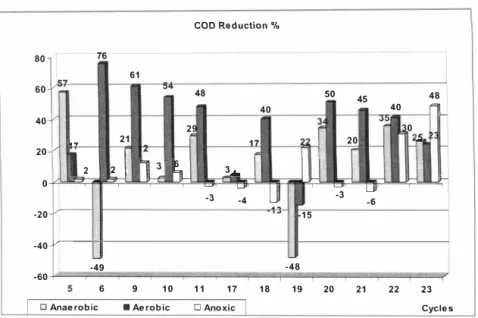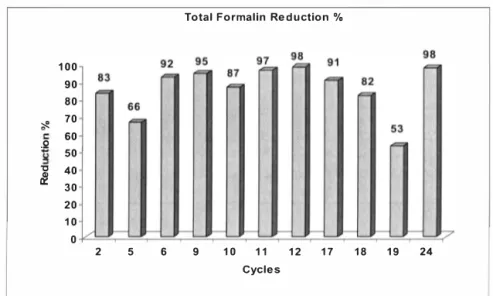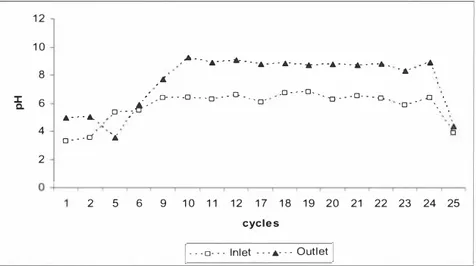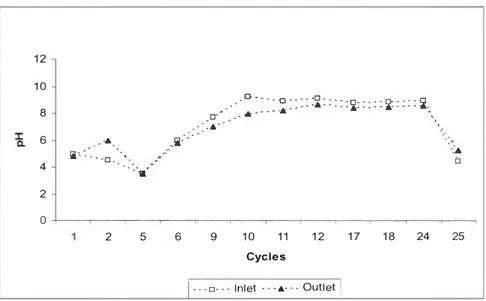Kalmar ECO-TECH '07 KALMAR, SWEDEN, November 26-28, 2007
PRELIMINARY TREATABILITY TEST OF A
NON-CONVENTIONAL INDUSTRIAL
WAS TEW ATER IN THE WOOD SECTOR: COD
AND FORMALIN REDUCTION
1, 2Fabio Kaczala
13 M,arc,a
. M,arques,
1William Hogland
1University of Kalmar-HiK, Sweden
2The CAPES Foundation, Brazil Ministry of Education, Brazil
3Rio de Janeiro State University-UERJ, Rio de Janeiro, Brazil
ABSTRACT
Industrial activities commonly discharge a broad range of synthetic compounds directly into water recipients without previous treatment. Despite the existence of available technologies for industrial wastewater treatment, better understanding of treatment processes is still required, since these waters are relatively complex and usually contain either persistent or recalcitrant compounds. Treatment systems with low costs of implementation, operation and maintenance as well as energy and labor saving processes ought to be developed. Biological treatment systems are potentially good options to meet these requirements. In this study, a preliminary investigation in lab scale was carried out with a Sequencing Batch Reactor -SBR used to treat a non-conventional industrial wastewater generated by a wood-floor industry, located in Nybro, Sweden. The study focused on: (i) formalin reduction in aqueous phase and; (ii) COD reduction. The proposed SBR reached a high efficiency in reducing formalin within the aqueous phase (from 53% to 98%) suggesting the use of formalin by the microorganisms as a primary carbon source. On the other hand, COD reduction (-34% to 73%) was not satisfactory, which is probably related with the presence of polymeric compounds with high molecular weight in the urea-formaldehyde resin, Recommendations for the system improvement are: (i) effluent recirculation; (ii) longer filling periods during each batch and; (iii) both primary and secondary settling/ sedimentation. As a result of very high initial COD contents (ranging between 736-5608 mg L·\ even though a high percentage of reduction is achieved, the final effluent would still not meet the threshold limits for effluent discharges in water bodies. Additional treatment options could be advanced oxidative processes such as ozonation and Fenton.
Kalmar ECO-TECH '07
KALMAR, SWEDEN, November 26-28, 2007
synthetic compounds are used by different manufacturing processes being discharged afterwards in water bodies without previous treatment [ 1], Despite the availability of technologies to treat industrial wastewaters, there is a need for efficient systems with low costs of implementation, maintenance and operation. In terms of economical feasibility, when compared to other technologies, biological systems are in the frontline, being much less costly [2]. Biological treatment has been widely accepted and used for either partial or complete stabilization of biologically degradable substances, present in wastewaters [2]. It is widely reported in literature the use of anaerobic processes in many industries for the treatment of wastewater with relatively high content of organic pollutants due to its performance, cost and energy saving advantages [3, 4, 5, 6], Industrial wastewaters, particularly those generated after washing/cleaning of machineries and equipment vary both quantitatively and qualitatively in time, which threat the proper function of biological treatment systems. Therefore, there is still a demand for knowledge development regarding operational parameters and how to achieve optimum conditions and improved treatment efficiency [7, 8]. In the present study, the biological approach for treating a wastewater stream generated in a wood floor industry located at Nybro, Sweden is preliminarily evaluated. The wastewater is generated at the cleaning/washing procedures of machineries that continuously apply urea formaldehyde resins on the wood particle boards. The main characteristics of such wastewaters are the high contents of fonnalin and very high content of COD. The objective in this stage of the investigation was to assess the treatability of this wastewater through biological processes and the performance of the treatment system, with focus on: reduction of formalin in aqueous phase and; reduction of COD.
2. MATERIAL AND METHODS
The bench-scale experiment was divided in two stages: Stage I: Microbial growth and attachment onto an inorganic filter media; Stage 2: Treatability experiment.
Due to the intermittent generation of the wastewater to be treated, a Sequencing Batch Reactor (SBR) was proposed (see Figure 1). The system, specifically designed and built up for this experiment consisted of two cylindrical reactors ( external diameter 10 cm and height 21 cm) functioning in sequence. The first phase consisted in anaerobic conditions and the second in intermittent aeration to establish alternated aerobic-anoxic conditions (see Table 1). The anaerobic phase included the following steps: (i) filling; (ii) anaerobic degradation sedimentation and (iii) discharge. The aerobic-anoxic phase included: (i) filling; (ii) aeration aerobic degradation; (iii) aeration interruption-anoxic phase and; (iv) discharge.
Kalmar ECO-TECH '07
KALMAR, SWEDEN, November 26-28, 2007
Figure 1: SBR lab-scale constructed for glue wastewater treatment: (an) anaerobic phase; (ae) Intermittent Aeration (aerobiclanoxic phase),
The temperature during the anaerobic and aerobic-anoxic phase ranged between 25-32 °C (kept through a thermal plate underneath the reactor) and 20-23 °C respectively (room temperature), Whereas the filling procedure was done with a peristaltic pump (Watson Marlow-Ali tea M20 10- 100 rpm Dual channel) in an up-flow mode, the discharge was done in a down-flow by gravity, Before filling the anaerobic phase, the influent had the pH adjusted to the range between pH 6-7 either with a NaOH (IM) or HCI (0. 1 M), except for those batches where the intention was to investigate the influence of the pH over the system efficiency.
Stage I -Microbial growth and attachment phase: Activated sludge taken from the Kalmar Municipal Wastewater Treatment Plant (K WWTP) was used as inoculum to promote microbial growth and attachment onto the filter carriers, The sludge was stored at 4 °C, In order to put the microorganisms in contact with the carriers, 600 ml beackers were filled with 100 ml (4.e16 g ML VSS/L) of activated sludge plus synthetic medium (see Table 2) and the filter carriers (ceramic and polymers), The beackers were immersed in a water bath, kept at constant temperature of 30 °C, During a one-month period, every second day the activated sludge within the beackers was carefully disposed off and replaced with a fresh batch prepared with the same material previously mentioned (activated sludge+ synthetic medium). The procedure was handled carefully in order to avoid biofilm slough off After 30 days, filter carriers were put into the cylindrical reactors and the treatability experiment had commenced,
Kalmar ECO-TECH '07 KALMAR, SWEDEN, November 26-28. 2007
Table I. Physical and hydraulic characteristics of the SBR phases.
Phases Anaerobic Aerobic Anoxic
Process Fluidized bed Packed bed Packed bed
Flow Up flow Up flow Up flow
Filter carriers Polymeric (50-70 µm pore size) Ceramic rings* Ceramic rings*
Total vol . 1.65 L 1.65 L 1.65 L
Effective vol. 0.6 L 0.6 L 0.6 L
* Porosity non-defined.
Stage 2 - Effluent Treatment Evaluation: This stage was divided in 4 phases consisting in:
(i) feeding with an influent initially diluted 20 times + co-substrates (KH2PO4, K2HPO4, Glicose, CuCl2 and NH4CI) (day 1-26);
(ii) feeding with influent without co-substrate (day 27-38); (iii) induced metabolic stress and starvation (day 39-75);
(iv) Post-metabolic stress (day 76-120) when the dilution factors used during the experiment were progressively reduced until it reached the condition of effluent with no dilution by the I 00th day.
In every cycle, influent and effluents from the following four sampling points were analyzed: anaerobic influent (SI); anaerobic effluent (S2); aerobic effluent (S3) and anoxic effluent (S4). The following parameters and analytical methods were used: pH (Digital pH meter -WTW Multi 340i), Dissolved Oxygen (Digital Oxymeter -WTW Multi 340i), Formalin and COD (LCK 325 and LCK 1 14 respectively according Dr Lange Diisseldorf, Germany). Moreover, CO2 and CH4 were monitored (8 samples) with Buch & Holm GA 2000 gas
analyzer. A summary of the operational conditions is found in Table 3.
Table 2. Synthetic medium used for the microbial af/ached growth.
mg 100 mL-I NH4CI 160 ·1
"'
CaCl2*2H20 22.5...
MgC'2*6H20 30 ·,:....
FeC'3*4H2O 6 C6H12O6 2000 Buffer KH2 PO4 81 Solution K2HPO4 113 MnC'2*4H2O 0.e15"'
....
H38O3 0.0e15...
ZnCl2 0.0e15...
CuCl2 0.009...
Na2 MoO4*2H2O 0.003 C0Cl*6H2O 0.e15 NiCl2*6H2O 0.0e15 Na2SeO3 0.0e15�
�
�
�
�
�
�
�
�
-2-5 -2-3 -1-2
Kalmar ECO-TECH ·07 KALMAR, SWEDEN, November 26-28, 2007 Table 3. Summa,y of !he operalional conditions of the SBR.
Process Anaerobic
•
Aerobic AnoxicStase 0-26 26-38 76-120 0-26 26-38 76-120 0-26 26-38 76-120 HRT 2-5.5 2-5 3 I-LS 1-2 2 0.5-2 1-3 (da�s) Filling 30 30 60 - 90 30 30 30 (min) Degrad -2-5.5 (da�s) -3-5 -I-LS - 1-2 -0.5-2 -1-3 Temp 29-32 29-32 25-32 20-23 20-23 20-23 20-23 20-23 20-23 ('C) eH 3.5-10 6-10 4.5-10 3.3-6 6-9 6-9 3.5-6 7-9.2 8.4-9 *The induced metabolic stress with increased Hydraulic Retention Times-HRT.
3. RESULTS
COD reduction: The total COD reduction along 26 cycles during four months (average of 6.5 cycles per month) ranged between -34% and 73% (Figure 2). The observed oscillation in efficiency can be related to the presence of polymeric compounds in the glue, with a relatively high molecular weight characterized by persistence and in the worst case, recalcitrance [9] and changes in the running conditions, such as nutrients availability. As a consequence, whereas in some cycles (5, 6, 9, 11, 22 and 23) the system achieved a satisfactory efficiency, in others, it didn't During Cycle 3, for instance, the insignificant reduction of total COD (3%) was probably due to the previous metabolic stress suffered by the system, with higher retention times than usual and a consequent starvation process. According to [IOJ the lack of nutrients within a SBR resulted in inhibition of microbial metabolism with a low rate of biological transfomiation and mineralization of organic compounds. Moreover, during Cycle 19, the total COD reduction was negative (-34%), suggesting either the production of particularly persistent or recalcitrant by-products as a result of biological transformation of the original compounds in the influent, a phenomenon already described in the literature [II]. According to [11], the majority of the organic compounds in an effluent after biological treatment was not detected in the original influent, but were actually produced by the system. Yet, according to the authors, the environmental conditions (pH, nutrient deficiency, presence of toxic compounds) and operational parameters play important roles as regards certain by product compounds and its building up processes [II]. Similarly, [6] reported negative reduction of COD in a UASB system until the 40th week of operation, correlating it with difficult hydrolysis and consequent accumulation of dissolved organic matter.
Nevertheless, in the present investigation, the negative reduction of COD (partial and total) in some cycles remains with no explanation. [II] mention the presence of dissolved organic matter such as exopolymeric substances produced by attached biomass that possibly contribute to the organic matter content. Advanced analytical methods are required to detect these substances, being this investigation planned for a near future.
Kalmar ECO-TECH '07 KALMAR, SWEDEN, November 26-28, 2007
Total COD Reduction %
73 80 60 � 40 C .!? 'S 20 73 70 -20 -34 -40 5 6 9 10 11 17 18 19 20 21 22 23 Cycles
Figure 2: Total COD reduction achieved by the SRB including all phases.
In order to identify the treatment phase responsible for the COD increase, Figure 3 shows the reduction in each phase of the biological process (anaerobic-aerobic-anoxic). During Cycles 6 and 1 9, the anaerobic phase was responsible for a COD increase. It can also be observed during the anoxic phase; low negative reductions in Cycles 1 1, 1 7, 1 8, 20 and 21 (see Figure
3).
Non satisfactory values of COD reduction at the anaerobic phase may be related to the presence of easily degradable organics as carbon sources for the microbiological metabolism, which in turn, might inhibit the production of specific enzymes capable of transfonning and degrading more complex compounds. Still based on Figure 3 the percentage of COD reduction showed a reducing trend along the experiment. This fact can result from the decrease of dilution factor with consequent raise of persistent and recalcitrant compounds. Formalin Reduction: In Figure 4 a total formalin reduction ranging between 53 and 98% along the experiment is observed. While the formaldehyde toxicity has been widely reported in literature, in the present study it was considered irrelevant. The results suggested that formaldehyde was actually used as a primary carbon source by the attached biomass, principally when considering both anaerobic and aerobic phases (Figure 5). In a previous study with the same source of wastewater, [ 12] mention the possibility of antagonistic effects with reduced formaldehyde toxicity when in the presence of other compounds. Such hypothesis requires further investigation.
·�
�. 45 -3 -49 Kalmar ECO-TECH ·07 KALMAR, SWEDEN, November 26-28, 2007COO Reduction¾ ... 76 80 61
�
..
60 48 50 48��
40 40 40-�
2J 0 21 17"
20�
,.
20 V' 2 2 3�I
I
1:
�
f
�
'
;�
N�
0�-
-
u
-4�
-
-3 -6 ,.--20 15 -40 ,;----48 -60 6 9 10 11 17 18 19 20 21 22 23□Anaerobic ■ Aerobic D Anoxic Cycles
Figure 3: COD reduction efficiency of the different biological phases in the SBR.
An interesting fact was observed during the cycle 19, when the system performed its lowest efficiency regarding formaldehyde reduction (53%) and COD (-34%). This cycle coincided
with the lowest values of formaldehyde and COD in the influent (24 mg L.e1 and 737 mg L'e1
respectively).
Regardless the pH variation at the anaerobic influent, the system presented a buffering
capacity in the range of 6 < pH < 7, principally taking into account the cycles 9-13 and 17-24
(Figure 6). The outlet pH in the acidic range suggests the presence of organic acids, and a formaldehyde shock loading (221 mg HCOH L'1 da/) at cycle 25 might be the principal cause of an outlet pH of 3.9. [13], highlight that a typical response of organic shock loading is that pH decreases down to an acidic range as a consequence of organic acids accumulation, Figures 7 and 8 show the pH variation within the intermittently aerated reactor. It is clearly observed that whereas the pH is raised during the aerobic phase, when the aeration is turned off a decreasing trend for the pH occurs. No significant variation of inlet and outlet pH is observed, being reasonable to associate that with a buffering capacity of the system as a whole, both for the neutral (anaerobic phase) and alkaline range. Further investigation of the nitrification-denitrification process is expected to bring better understanding as regards pH dynamics along the treatment system, principally within the intennittently aerated phase.
�
Kalmar ECO-TECH '07
KALMAR, SWEDEN, November 26-28, 2007 Total Formalin Reduction ¾
100 90 80 70 Ji! 60 50
�
"ti 40 30 20 10 0 2 5 6 9 10 11 12 17 18 19 24 CyclesFigure 4: Tota/formalin reduction achieved by SRB including all phases.
100 80 60 40 20 0 -20 2 5 6 Formalin Reduction% 91 91 87 9 10 11 12 17 18 Cycles
□ Anaerobic • Aerobic D Anoxic
Kalmar ECO-TECH '07 KALMAR, SWEDEN, November 26-28, 2007
12
p.
10 ·□, _r;i.
D··D·· · □
8
I 6 A .. • ..•� u{I-< ,e,: �: :•·•·.�. .-_-... · • /.•
:--
_.•;a•{·•. b
• .
.
□[I C. . .a···•··•··,.;·· D · ·d ti 4
·-...
..-•
2 0+-�-��-��-��-��-��-��-��-��-��� 2 3 5 6 7 9 10 11 12 13 17 18 19 20 21 22 23 24 25 26 Cycles1--
-
□· · - inlet - • • •· - • outletI
Figure 6: Inlet and Outlet values of pH within the anaerobic phase along the experiment
12 10 8 I 6 4 2 C. •···&. □·--□ ... •· ..•.. -•... •· .. ·• . . •. . ·.A:
-"
□ □ ---- .□-.. ·□ .. ·□·. - 0 .. ·□ · . ·•- ---u-·•□•--o. .a . -□ · · ---� -□--- ·._ · .. -. 2 5 6 9 10 11 12 17 18 19 20 cyclesI-
--
□- --Inlet .. ••· .. OutletI
21 22 23 24 25: : : �� : : : : : : � : : : : :'.i : : : : : l'_: : : : : i : - - - � -□ Kalmar ECO-TECH '07 KALMAR, SWEDEN. November 26-28. 2007
1 2 1 0
·
- < •
8.
- ·.
6 .... . ..Ii: Ii'• ·--· - -□.>•
.
...
[] 4·.·•·
2 0 +--�---,�-�-�--�-�-�--�-�---,--�----, 2 5 6 9 1 0 1 1 1 2 1 7 1 8 24 25 CyclesI ·••
□· - • Inlet - • • •-- • OutletI
Figure 8: Inlet and Outlet values of pH within the anoxic phase along the experiment 4. CONCLUSIONS
According to the results, the proposed system in a bench scale showed capacity to remove with high efficiency formaldehyde (53% to 98%), suggesting the utilization of fonnaldehyde as a carbon source by microorganisms. On the other hand, the system did not achieve a satisfactory COD reduction (-34% to 73%), which might be related to the presence of either persistent or recalcitrant polymeric compounds with high molecular weight at the Urea formaldehyde resins. Recommendations for further investigation are: (i) effleuent recirculation; (ii) longer feeding periods; (iii) primary and secondary settling/sedimentation systems.
It is important to emphasize that even though the treatment system might be able to achieve high efficiency in reducing COD, very high initial COD values would still result in effluents with values above the threshold limits for effluent discharge. Options for a final polishing include advanced oxidation processes such as ozonation and Fenton.
AKNOWLEDGEMENTS
The CAPES Foundation - Brazil Ministry of Education is acknowledged for the first author's PhD scholarship. The authors are thankful to the financial support from AB Gustaf Kiihr and particularly the relevant assistance from the Environmental Manager Mr Ake Erlandsson. The financial support from Akzo Nobel, Beckers Acroma, Swedwood International and Kalmar Energi and Swedish Institute is here recognized.
Kalmar ECO-TECH '07 KALMAR. SWEDEN, November 26-28, 2007
REFERENCES
I . Schwarzenbach, R. P., Escher, B.L, Fenner, K., Hofstetter, T.B., Johnson, C.A., Yon Gunten, U. & Wehrli, B. 2006. The Challenge of Micropollutants in Aquatic Systems. Science. 313:
I 072-1077.
2. Cheremisinoff, P.N. 1994. Biomanageement of Wastewater and Wastes. 221 pp. Water and Wastewater Treatment Guidebooks. Prentice Hall Ed, New Jersey, USA.
3. Chinnaraje, S. & Yenkoba Rao, G. 2006. Implementation of an UASB anaerobic digester at bagasse-based pulp and paper industry. Biomass and Bioeenergy. 30:273-277
4. Mahmoud, N. 2002. Anaerobic Pre-treatment of sewage under low temperature (15e° C)
conditions in an Integrated UASB-Digester System. PhD Thesis, Wageningen University, Wageningen, The Netherlands.
5. Oktem, Y.A., Ince, 0., Donnely, T., Sallis, P., & Ince, B.K. 2006. Determination of optimum operating conditions of an acidification reactor treating a chemical synthesis-based phannaceutical wastewater. Process Biochemistry. 4 I :2258e-2263
6. Luostarinen, S., Sanders, W., Kujawa-Roeleveld, K. & Zeeman, G. 2007. Effect of temperature on anaerobic treatment of black water in UASB-septic tank systems.
Bioresource Technology. 98: 980 - 986
7. Leitao, R.C, santaella, S.T., Yan handeel, A.C., Zeeman, G. & LETTINGA, G. 2006. The effects of hydraulic and organic shock loads on the robustness of uptlow anaerobic sludge blanket reactors treating sewage. Water Science and Technology. 54:49-55.
8. Mc Kinney, R.E. 2004. Environmental Pollution Control Microbiology. Ed Michael D.
Meyer. Dept. of Civil and Environmental Engineering, Georgia Institute of Technology. Atlanta, Georgia, USA.
9. Garrido, J.M., Mendez, R. & Lema, J.M. 2000. Treatment of wastewaters from a formaldehyde-urea adhesives factory. Wat er Scieence and Technology. 42:293-300 10. Wang, Z. W., Li, Y., Zhou, Jia-Qi & Liu, Y. 2006. The influence of short-tenn starvation
on aerobic granules. Process Biochemistry. 41:2373-23 78
11. Aquino, S.F. & Stuckey, D.C. 2006. Chromatographic characterization of dissolved organics in effluents from two anaerobic reactors treating synthetic wastewater. Water Science and T echnology. 54: 193 - 198
12. Kaczala, F., Marques, M . & Hogland, W. 2007. The study of formaldeehyde Toxicity over Activated Sludgee (In Portuguese). In: 24e° Congresso Brasileiro de Engenharia Sanitaria e Ambiental. 2-7 September, 2007. Belo Horizonte, Minas Gerais -Brazil
13. Leitao, R.C., Yan Handeel, A.C., Zeeman, G . & Lettinga, G. 2006. The effects of operational and environmental variations on anaerobic wastewater treatment systems: A review. BioreesourceTechnology.97: I I 05-111
